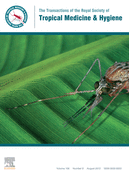-
Views
-
Cite
Cite
A. Daryani, M. Sharif, M. Nasrolahei, A. Khalilian, A. Mohammadi, Gh. Barzegar, Epidemiological survey of the prevalence of intestinal parasites among schoolchildren in Sari, northern Iran, Transactions of The Royal Society of Tropical Medicine and Hygiene, Volume 106, Issue 8, August 2012, Pages 455–459, https://doi.org/10.1016/j.trstmh.2012.05.010
Close - Share Icon Share
Abstract
Parasitic infection is highly prevalent throughout the developing countries of the world. Research on the prevalence of intestinal parasitic infections in various geographic regions is a prerequisite for the development of appropriate control strategies. A cross-sectional study was conducted to determine the prevalence of intestinal parasitic infections among schoolchildren in public primary and secondary schools in the urban areas of Sari, Mazandaran province, northern Iran. The study was conducted from November 2009 to June 2010. A total of 1100 stool samples from 607 males and 493 females aged 7–14 years were examined by direct wet mounting, formalin-ether concentration, and Ziehl–Neelsen and trichrome permanent staining methods. A parental questionnaire for common risk factors was completed for each participant. Mono- or poly-parasitism was detected in 367 (33.3%) of the children (32.6% of males and 34.2% of females). Various species of protozoan or helminth infections were detected: Blastocystis hominis seemed to be the most prevalent parasite (13.5%) followed by Giardia lamblia (10.6%), Entamoeba coli (7.2%), Endolimax nana (1.5%), Enterobius vermicularis (2.2%), Trichostrongylus sp. (2.1%) and Strongyloides stercoralis (1.6%). The prevalence of intestinal parasite infections in females was slightly higher than in males, though without a statistically significant difference (p=0.56). No age association was detected, and a slightly lower positive association with increasing age was observed (p=0.33). A significant association was observed with parents' educational level, household income and practice of hand washing before meals (p<0.01). Although paediatric pathogenic intestinal parasite infections are not more prevalent in this geographical area than in other regions, improvements in personal hygienic conditions and behavioural characteristics is important to completely control parasitic infections in schoolchildren in northern Iran.
- giardia lamblia
- blastocystis hominis
- child
- developing countries
- educational status
- endolimax
- entamoeba
- ether, ethyl
- ethers
- geographic area
- helminthiasis
- income
- infectious mononucleosis
- parasitic intestinal diseases
- intestines
- iran
- parasites
- parasitic diseases
- parent
- pediatrics
- strongyloides stercoralis
- trichostrongylus
- infections
- behavior
- formaldehyde
- helminths
- protozoa
- washing hands
- school-age child
- enterobius vermicularis
- stool specimen
- secondary schools






Comments